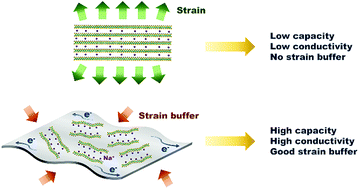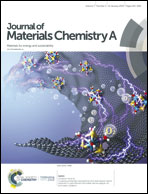Strain buffering effect of quasi-amorphous disordered microstructure enabling long-term fast sodium storage performance†
Abstract
Volume expansion during the discharging and charging processes is still a challenge for high-capacity electrode materials. The direct design of active materials with high surface area can overcome this challenge, but would inevitably decrease the volumetric energy density. Herein, a quasi-amorphous disordered microstructure of MoS2, combined with a conductive matrix, was designed to improve the cyclability and high rate performance. The hybrid electrode materials with optimized architecture have shown the buffering effect of the loosened structure and the enhanced conductivity. Moreover, this special structure has favoured pseudocapacitive charge storage behaviour, further contributing to the excellent electrochemical performance. As expected, after 3000 cycles, the reversible capacities remained as high as 322 mA h g−1 (1 A g−1) and 281.6 mA h g−1 (2 A g−1), both presenting low cyclic fading rates of 0.01% per cycle. After 1000 cycles at 6 A g−1, a capacity of 226.7 mA h g−1 was achieved. Even at an extremely high current density of 45 A g−1, it could still deliver a high capacity of 257.7 mA h g−1. We anticipate that suitable structure modulations might be applied to other electrode materials to meet the optimal electrochemical reaction and kinetic requirements.



 Please wait while we load your content...
Please wait while we load your content...